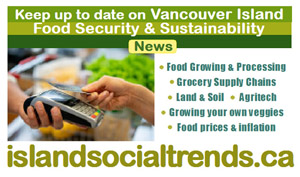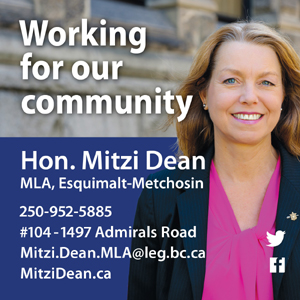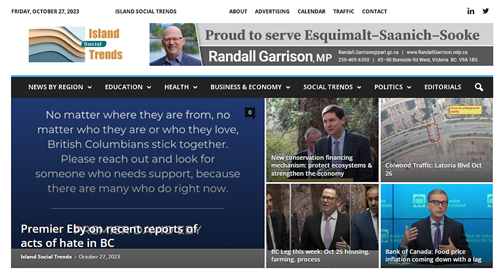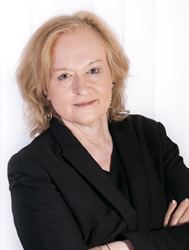
Saturday October 28, 2023 | VICTORIA, BC [Updated October 29, 2023]
Economic analysis by Mary P Brooke | Island Social Trends
This past week the Bank of Canada held steady and did not increase their benchmark interest rate above 5.0%. That October 25 announcement was a repeat performance of their September 6 announcement.
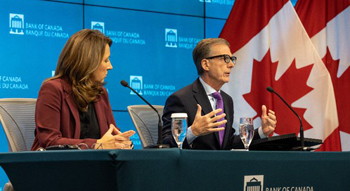
This comes after 10 previous increases to the Bank’s interest rate between March 2022 and July 2023.
The latest increase on July 12 was the tenth within the past 19 months: there were seven increases in 2022, an eighth in January 2023, the ninth in June, and then in July. The last two increases were small at 0.25% compared to larger previous increases that took interest rates from 0.25% to 5.0%.
Still gunning for target range:
The difference this month compared to last, is that Bank of Governor Tiff Macklem is sounding more hawkish. He has never said anything other than that the central bank would persist until the rate of inflation finds itself back around 2% or 3%. Now it comes with even firmer tones.
That target range for inflation is founded in a standard bank philosophy that when inflation is in the range of 2% to 3% it’s gentle enough so that people don’t really ‘notice’. In that range, it’s generally given that businesses won’t find themselves wanting to continually crank up prices of products and services, and that banks and credit card companies won’t crank up charge and interest rates on their various financial products.
Inflation 2.0:
Inflation is different this time around. Food prices went up faster than expected, people still had some pent-up savings from the pandemic period, strong employment numbers lasted longer than the Bank of Canada expected them to, and people kept spending.
This is a new type of inflation. It’s not like in the 1970s and 1980s when the job market was cohesive and manageable, and when unemployment insurance managed most of the pitfalls for otherwise employed people. Even in the 1994 inflationary period there was a type of familiarity that things would work out relatively quickly.
In 2022 and 2023 things are different. Not just the major factors like GDP and unemployment, but significant pitfalls that could see people fall off financial cliffs and never really recover. Mortgage-holders are renewing at higher rates than they might be able to afford (and some will lose their home ownership status). Renters are paying increasingly higher rents as landlords/owners hope to cover costs. Grocery stores are ‘covering their behinds’ so to speak, by keeping prices comfortably high (to their liking).
Credit cards, banks, the insurance sector and producers of other daily or monthly costs for households and businesses have readily put up prices, just in case. Household debt is at its highest level ever in Canada, with an increasing number of people paying less and less toward the balance owing.
The idea of ‘affordability’ is very much out the window, something that Island Social Trends has been writing about for years. There is almost no middle class left, as people find themselves working hard yet falling steadily behind.
Banks, corporations and governments find themselves pressured to revise their approach to inflation. Will it be enough, fast enough? How many people will fall between the cracks, especially in ways that a stable financial scenario is irretrievable?
This last 20 months of an upward inflationary cycle has set many people, households and small businesses significantly below their usual living standard. Few people mention ‘the gig economy’ anymore, but that’s only one way that people make ends meet; holding two or three jobs is not uncommon.
Use of food banks has skyrocketed in the last year and a half, with many full-time working people needing help and nearly half the people supported being children.
Challenging the status quo:
The premise that the target inflation range is valid has been challenged by economist Jim Stanford in the pandemic recovery phase. He was particularly succinct in his comments as a guest on CTV’s Taking Stock business news program this weekend.
Stanford made two key points:
- this time around (compared to the 1970s or 1980s) inflation has not been caused by ‘excess demand’ (as the Bank of Canada would have it) but by “global harvest” (perhaps impacted by climate change) as well as supply chain disruptions (pandemic, war in Ukraine); and
- government financial supports to low-income folks don’t contribute to inflation but rather are just helping people cope (in some cases literally hang on) until things stabilize.
Stanford is director of the Centre for Future Work and author of Economics for Everyone. He is with the Economics Department at McMaster University in Hamilton and an Honorary Professor of Political-Economy at Sydney University.
He is a regular contributor to the Canadian Centre for Policy Alternatives (CCPA).
Macklem acknowledges supply chain impact on food prices:
The Bank of Canada governor did say on October 25 (in response to a question from Island Social Trends) that yes, the Bank of Canada was surprised at the rapid increase in retail grocery prices. He did say that “the rapid run up” was led by supply chain interruptions.
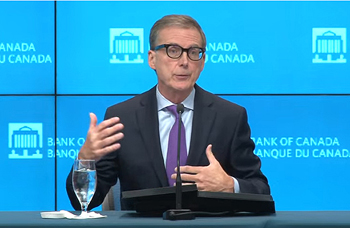
Macklem said he sees food price inflation coming down, but ‘with a lag’.
Corporate behaviour hasn’t normalized:
But Macklem also — for the first time — referred to “corporate behaviour” as part of grocery price increases and presumably other actions by large companies whose products and services are integral to consumer financial activity and well-being. He said that corporate behaviour “hasn’t normalized”. In other words, big companies are still taking advantage or at least being reckless with applying price increases within an environment of economic uncertainty.
On Wednesday Macklem went so far as to say that “corporate behaviour” is now a “risk factor” within the plan to tamp down inflation to the target range. He may hang his hat on that when it comes time for decision-making on the next rate hike on December 6.
Supports to low-income households:
The point that low-income households need some ‘handouts’ to help make ends meet was something that began to actively dawn on governments at the start of the pandemic.
Some more conservative-leaning political parties feel there is a ‘middle class squeeze’ going on, because folks in the middle-income range aren’t receiving some or any of those financial supplementary payouts.
However, governments must look at the bigger operational and social stability of a country or province, with financial considerations being one part of that. A society that would effectively ‘see the bottom fall out’ — i.e. if people weren’t able to pay bills, buy groceries, have a roof over their head (worse than it is already), there would be a rapid decline in social order likely an increase in various types of crime. There would also be social despair — with impacts on families and the health-care system.
Household supports in BC:
In BC there were CERB top-ups during the pandemic, a couple of affordability credits (including one through the BC Hydro billing system) during the pandemic recovery phase, and top-ups to the doubled federal GST rebate this year.
Island Social Trends asked Premier David Eby this past week if there would be another affordability credit at 2023 year-end — a sort of Christmas bonus or new-year support; we’re yet to hear what might come of that.
Comments from premiers:
Did the Bank of Canada heed the plea of BC’s Premier in August when Eby wrote in a letter to Macklem and team that any further interest rate hikes would be incredibly onerous on households and small businesses (the premiers of Ontario and Newfoundland and Labrador followed suit). We may never know for sure (the Bank likes to maintain its autonomy) but this week Macklem did say “there’s no question that food price inflation has particularly affected lower income more vulnerable members of society”.
Previously, that sort of comment would not be made by a Bank that would have hoped to maintain a blind spot about the real-life day-to-day impacts of their high-level monetary policy decisions.
===== RELATED ARTICLES by ISLAND SOCIAL TRENDS:
- Urban food resilience requires municipal leadership (October 29, 2023)
- Bank of Canada: Food price inflation coming down with a lag (October 25, 2023)
- Next Bank of Canada rate announcement Oct 25 (October 24, 2023)
- NDP still pushing for grocery price action (October 18, 2023)
- Macklem: Rates will come down but we’re not there yet (September 7, 2023)
- Bank of Canada holds interest rate steady (September 6, 2023)
- Next Bank of Canada rate decision Sept 6 – BC & Ontario premiers speak up (September 4, 2023)
- 10th Bank of Canada rate increase in 16 months (July 12, 2023)
- Premier Eby on July 12 Bank of Canada rate increase (July 12, 2023)
- Premier Eby: Interest rate hikes impacting people who can least afford it (July 11, 2023)
- Next Bank of Canada update coming July 12 (July 7, 2023)
- Bank of Canada Deputy Governor draws a crowd in Victoria (June 8, 2023)
===== ABOUT THE WRITER:
Island Social Trends Editor Mary P Brooke has been reporting on south Vancouver Island and BC news through a socioeconomic lens for now over 15 years.
Ms Brooke founded, wrote and published MapleLine Magazine (2008-2010) which was followed by launching the Sooke Voice News weekly newspaper that brought a second voice to news of the Sooke region (2011-2013). Expanding her publication to the weekly print/PDF West Shore Voice News, Mary Brooke began the broader geographical coverage and even deeper sociological and political coverage (2014-2020).
Island Social Trends was the extension of those print publications, launching full online mid-2020 at IslandSocialTrends.ca. That will be expanded, as well, into print/PDF starting January 2024.
Mary Brooke is a business woman who holds a B.Sc. (Foods & Nutrition, sociology & consumer education), a Certificate in Public Relations, and a certificate in Digital Marketing. Her journalism adheres to the principles of Plain English and Accessible Writing, as well as Canadian Press Style.
Ms Brooke reports with the BC Legislative Press Gallery. In 2023 she was nominated for a Jack Webster Foundation award that recognizes the contribution of a woman journalist to her community through the work of journalism.




